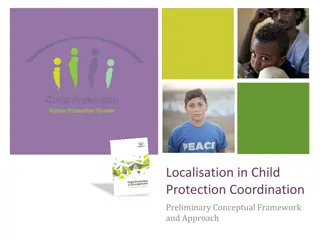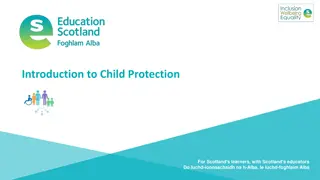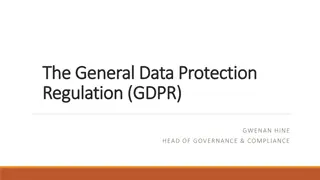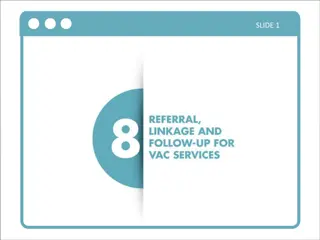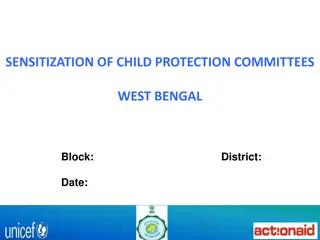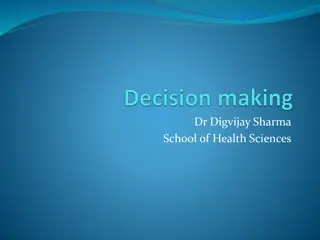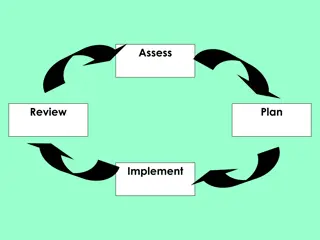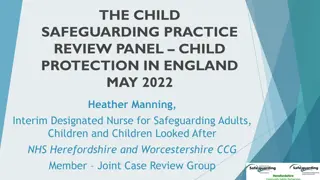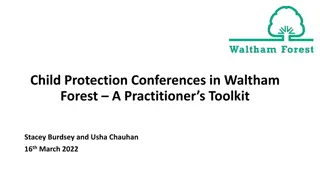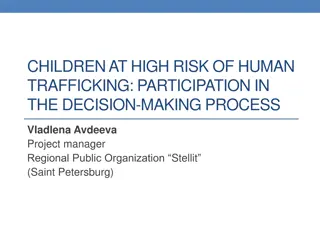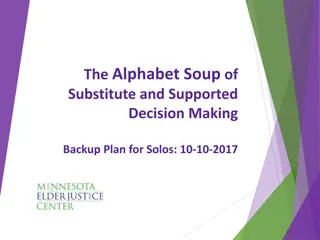Child Protection Conference and Decision Making Process
Child protection conferences are crucial meetings to determine the safety and well-being of a child at risk of harm. Attendees include practitioners, caregivers, and family members, aiming to create a protection plan. Children can have a voice through advocacy services. The Act emphasizes the individual's rights and the need for advocacy in safeguarding processes.
Download Presentation

Please find below an Image/Link to download the presentation.
The content on the website is provided AS IS for your information and personal use only. It may not be sold, licensed, or shared on other websites without obtaining consent from the author.If you encounter any issues during the download, it is possible that the publisher has removed the file from their server.
You are allowed to download the files provided on this website for personal or commercial use, subject to the condition that they are used lawfully. All files are the property of their respective owners.
The content on the website is provided AS IS for your information and personal use only. It may not be sold, licensed, or shared on other websites without obtaining consent from the author.
E N D
Presentation Transcript
Child protection conference Decision making and initial child protection conferences
Report received by social services Initial decision Strategy discussion/meeting Make report to social services Section 47 enquiries Discuss with line manager or DSP Child protection conference Safeguarding concern
Child protection conference Purpose:to make decisions about the child s future safety, well-being and development Must be held within 15 working days of the last strategy discussion/meeting Brings together family members (and the child where appropriate) with the supporters, advocates and practitioners most involved with the child and family Determines whether the child is at continuing risk of significant harm and requires a care and support protection plan and registration on the child protection register
Who attends? Those who have a significant contribution to make, arising from their practitioner expertise, their knowledge of the child/family, or both, such as: the child, caregivers, family members, advocates social services practitioners who have undertaken the Section 47 enquiries, the police education staff involved with the child paediatrician, examining doctor and/or the child s GP Normally, a minimum of three agencies/practitioner groupings that have had direct contact with the child is required
Children in the conference Attendance alone is not participation/giving the child a voice The child can be given a voice at the conference through: advocacy from a statutory Independent Professional Advocate (IPA), attending with and/or on behalf of the child presentation of a contribution prepared by the child active attendance at the conference
Advocacy Section 181(2) of the Act defines advocacy services as: services which provide assistance (by way of representation or otherwise) to persons for purposes relating to their care and support. The Act is based on the rights of the individual. Denying someone access to advocacy denies them many other opportunities to enact their rights, such as the right to live safe from abuse Children have the right to an advocate when they are involved in safeguarding processes Can be an informal advocate (appropriate friend or family member) or an Independent Professional Advocate commissioned by the local authority
Children in the conference Before the child s social worker will: explain the purpose and process of the conference seek their views as to how they would like to participate provide the opportunity to bring an advocate, friend or supporter enablethe child s language of choice, preferred medium of communication or any other specific needs After the child s social worker will: provide information/advice about complaints/appeals procedures if they disagree with the conference decision/s provide an opportunity for immediate discussion and debriefing
Children in the conference Follow-up visits should provide opportunity for the child or young person to: ask questions / seek clarification reflect on the experience understand the rationale/purpose of the plan learn about who will be working with the family discuss ways in which they would like to be involved
Parents in the conference Parents/caregivers must always be actively encouraged to attend the child protection conference The social worker must: inform them of the Section 47 enquiries outcome ensure that they understand the process that will be followed: the purpose of the conference how it operates their participation who attends possible outcomes
Parents in the conference Parents/caregivers must receive adequate preparation from a social worker before the conference to enable them to participate as fully as possible. Including: explaining the purpose of the conference and of registration, the process and their role within it, including using an advocate giving sufficient time to read the report and ask any questions helping prepare for the conference taking account of the wishes and feelings expressed by the child providing support and guidance
Role of the practitioner Those attending must have enough information and evidence to: Objectively analyse the situation, including: all s47 enquiry concerns / information / findings obtained family strengths and protective factors previous knowledge of family and service involvement Decide whether the child is at continuing risk of significant harm Decide what future action is required to safeguard and promote the well-being of the child
Preparation is key Attendees must: come to the conference with reports that provide relevant, proportionate information be prepared to: o summarise their report and highlight important points o interpret, analyse and explain their information o provide a view at the conference as to whether the child is at risk of harm and their name should be placed on the child protection register
Preparing for conference The report should: be available to the chair two working days before the conference distinguish between fact, observation, allegation or opinion utilise the Framework for the Assessment of Children in Need and their Families draw attention to any particularly sensitive or confidential information and/or concerns about possible violence or intimidation The report must be shared, discussed and explained with families at least the day before the conference using communication methods commensurate with the needs of the various family members
The initial conference The conference chair The primary role of the conference chair is to ensure that the conference is child-centred and that the protection, care and support needs of the child/ren are identified and addressed The chair should be independent of operational or line management responsibility for the case and trained in chairing child protection conferences
The initial conference Conference duration Conferences normally last two hours It is important to remember that family members: are trying to absorb significant information in an environment in which they are unfamiliar are likely to be anxious and stressed, which in turn affects the ability to concentrate
The initial conference Conference agenda reason for conference / tasks of participants sharing/summary of reports details of events leading up to the conference assessment of the Section 47 enquiries background information from all agencies views of children and family members analysis of all information shared consideration of the risks of harm explicit recommendations for managing risks
Conference decision Whetherthe child is at continuing risk of significant harm and requires a formal care and support protection plan / registration on the child protection register: a) the child has suffered ill- treatment or impairment of health or development as a result of abuse or neglect, and practitioners judgement is that further ill-treatment or impairment is likely b) practitioners judgement is that the child islikely to suffer ill-treatment or the impairment of well-being or development as a result of abuse or neglect
Reaching a decision Reaching decision should follow a structured process: the chair ensures information-sharing and discussion about the risk of significant harm is child-centred and relevant the chair summarises the discussion based on the facts presented at the conference and ensures conference members agree this is an accurate summary the chair asks each member of the conference for their view about the risks to the child and the need for a care and support protection plan, including the proposed content of such a plan in terms of risks to be addressed
Reaching a decision Decision making should maintain a child-centred approach and be guided by professional judgement Remember: No decision is damage free the key is making decisions that are in the best interests of the child Effective decisions are made based on a calculated and reasoned assessment and analysis of the risk Sound evidence based on the lived experience of the child and parent/s and the impact observed by practitioners is key Practitioners and the family should reach a shared understanding of the concerns
Conference decision Whetherthe child is at continuing risk of significant harm and requires a formal care and support protection plan / registration on the child protection register:
Whetherthe child is at continuing risk of significant harm and requires a formal care and support protection plan / registration on the child protection register: The child is experiencing or at risk of harm and should be Child isnot at continuing risk of harm but may have needs for care and support placed on the child protection register made subject of a care and support protection plan parents encouraged to continue with the needs assessment
Conference confidentiality Circumstances when information must be disclosed: Individual practitioners should contribute all relevant information held on their records Information received during the safeguarding process must be treated in strict confidence Parents/carers will receive a copy of the full record of the conference, unless the chair and conference members decide that it is not appropriate 1.Right to request personal information 2.Court and legal proceedings 3.Practitioner disclosure 4.Public interest
Child protection register A list of all children in a local authority area who are suffering or likely to suffer significant harm and who are currently subject of a care and support protection plan alerts all practitioners to the child s risk of harm confirms that a care and support protection plan is in place and must be complied with confirms that a social worker and a core group of practitioners are working with the child and family
Outline child protection plan An outline plan of the actions required to meet the child s needs and by whom, including: the way in which the plan will protect the child the shorter and longer term planned outcomes to be achieved the provision of any support, who will have responsibility for what actions, and specified timescales arrangements to monitor and evaluate progress against the plan A copy of the outline plan and a summary of decisions made at the initial child protection conference should be circulated within five working days
Additional conference tasks Confirm the care and support protection plan co-ordinator Identify membership of the core group of practitioners Establish how children and families will be involved Set timescales for core group meetings and production of the child protection plan The core group should meet within 10 working days of the date of the initial child protection conference and thereafter at monthly, but no more than at six weekly intervals



